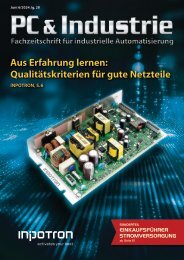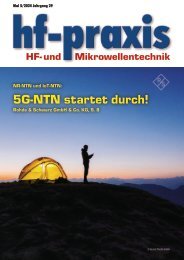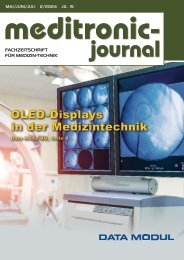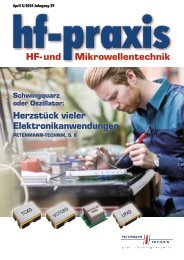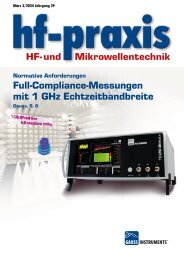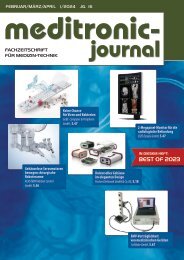12-2018
Fachzeitschrift für Hochfrequenz- und Mikrowellentechnik
Fachzeitschrift für Hochfrequenz- und Mikrowellentechnik
Sie wollen auch ein ePaper? Erhöhen Sie die Reichweite Ihrer Titel.
YUMPU macht aus Druck-PDFs automatisch weboptimierte ePaper, die Google liebt.
RF & Wireless<br />
Figure 2: Multiple frequency shift keying<br />
the antenna array and front-end<br />
electronics based on either III-V<br />
or silicon integrated circuit (IC)<br />
technologies.<br />
The NI AWR Design Environment<br />
platform integrates these<br />
critical radar simulation technologies<br />
while providing the<br />
necessary automation to assist<br />
the engineering team with the<br />
very complex task of managing<br />
the physical and electrical design<br />
data associated with ADAS electronics.<br />
ADAS support includes:<br />
Design of waveforms, baseband<br />
signal processing, and parameter<br />
estimation for radar systems,<br />
with specific analyses for radar<br />
measurements along with comprehensive<br />
behavioral models<br />
for RF components and signal<br />
processing.<br />
Design of transceiver RF/microwave<br />
front-end with circuitlevel<br />
analyses and modeling<br />
(distributed transmission lines<br />
and active and passive devices)<br />
to address printed circuit board<br />
(PCB) and monolithic microwave<br />
IC (MMIC)/RFIC design.<br />
Planar/3D EM analysis for characterizing<br />
the electrical behavior<br />
of passive structures, complex<br />
interconnects, and housings,<br />
as well as antennas and antenna<br />
arrays.<br />
The connection between simulation<br />
software and test and measurement<br />
instruments.<br />
Radar Architectures<br />
and Modulation<br />
For adaptive cruise control<br />
(ACC), simultaneous target<br />
range and velocity measurements<br />
require both high resolution and<br />
accuracy to manage multi-target<br />
scenarios such as highway<br />
traffic. Future developments<br />
targeting safety applications<br />
like collision avoidance (CA)<br />
or autonomous driving (AD)<br />
call for even greater reliability<br />
(extreme low false alarm rate)<br />
and significantly faster reaction<br />
times compared to current<br />
ACC systems, which utilize relatively<br />
well-known waveforms<br />
with long measurement times<br />
(50...100 ms).<br />
Important requirements for automotive<br />
radar systems include<br />
the maximum range of approximately<br />
200 m for ACC, a<br />
range resolution of about 1 m<br />
and a velocity resolution of 2.5<br />
km/h. To meet all these system<br />
requirements, various waveform<br />
modulation techniques and<br />
architectures have been implemented,<br />
including a continuous<br />
wave (CW) transmit signal or a<br />
classical pulsed waveform with<br />
ultra-short pulse length.<br />
The main advantages of CW<br />
radar systems in comparison<br />
with pulsed waveforms are the<br />
relatively low measurement time<br />
and computation complexity for<br />
a fixed high-range resolution<br />
system requirement. The two<br />
classes of CW waveforms widely<br />
reported in literature include<br />
linear-frequency modulation<br />
(LFMCW) and frequency-shift<br />
keying (FSK), which use at least<br />
two different discrete transmit<br />
frequencies. Table 1 compares<br />
the different radar architectures<br />
and their advantages and disadvantages.<br />
For ACC applications, simultaneous<br />
range and relative velocity<br />
are of the utmost importance.<br />
While LFMCW and FSK fulfill<br />
these requirements, LFMCW<br />
needs multiple measurement<br />
cycles and mathematical solution<br />
algorithms to solve ambiguities,<br />
while FSK lacks in<br />
range resolution. As a result, a<br />
technique combining LFMCW<br />
and FSK into a single waveform<br />
called multiple frequency shift<br />
keying (MFSK) is of considerable<br />
interest.<br />
MFSK was specifically developed<br />
to serve radar development<br />
for automotive applications and<br />
consists of two or more transmit<br />
frequencies with an intertwined<br />
frequency shift and with a certain<br />
bandwidth and duration, as<br />
shown in Figure 2 [1].<br />
As previously mentioned, pulsed<br />
radars are also widely used in<br />
automotive radar systems. Relative<br />
velocity can be determined<br />
from consecutive pulses using a<br />
coherent transmitter and receiver<br />
to measure pulse-to-pulse<br />
Table 1: Different radar architectures and their technical advantages/disadvantages in target detection, range, robustness, and resolution<br />
hf-praxis <strong>12</strong>/<strong>2018</strong> 59



